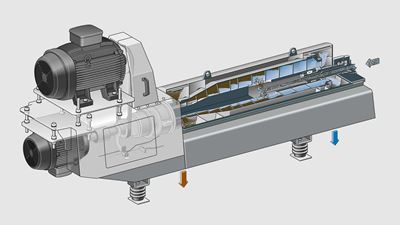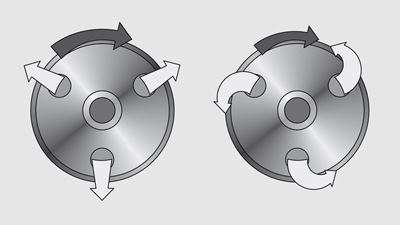Centrifuge
Clarifying decanters for bioethanol
Bioethanol, which depends on the fermentation of plant-based sugars and starches, is a gasoline substitute. The most commonly used feedstocks are corn and sugar cane.

Ethanol production from starch-based feedstocks like corn and wheat, creates tons of stillage which can be used in animal feed, preferably as dried distiller’s grain with solubles (DDGS). Decanter centrifuges separate the stillage into a centrate called "thin stillage" which contains proteins and microfibers, and a solids phase called wet cake that contains the coarse constituents of the grain's fiber.
The centrate (thin stillage) with proteins, yeast and microfibers, is evaporated to produce a syrup, also known as "thick stillage". If corn is used as feedstock the thick stillage also contains corn oil that can be obtained with centrifugal separators to get the most out of your raw material and process. After deoiling the thick stillage is mixed with the wet cake from the decanter and dried to form DDGS.
In ethanol production from sugar-based feedstocks like sugar cane or molasses vinasse is produced in the distillation stage. After further concentration by evaporation the vinasse concentrate is treated by decanters. The finally obtained vinasse products are used as additives in animal feed and as fertilizer.
Features & Benefits
- Highest separation efficiency and drier cake due to deep pond design with high g-volume, automatic differential speed adjustment and always full torque
- Energy efficient design: small solids discharge diameter and energy jets for less energy demand
- Robust and reliable operation: external gears for less exposure to high temperatures, oil + air lubrication for all main bearings
- Advanced wear protection: Tiles and tungsten carbide protection for longer uptime
- VFD drive for high flexibility because of bowl speed changing during production
- Compact Design: small footprint, easy access to all service relevant parts

The smaller the diameter of the discharged solids or liquids in a decanter centrifuge, the less the energy consumption. GEA decanters for bioethanol are in deep-pond design. Deep-pond designs come with smaller solids and liquid discharge diameters (DS2 and DL2) than shallow-pond designs (DS1 and DL1) which makes them very energy efficient. The difference in energy consumption can be up to 30 percent.

The discharge diameter is one feature to reduce energy consumption, energy jets is another. GEA Energy Jets deflect the discharged liquid in such a way that it supports the bowl's rotation (right). This results in energy savings of up to 10 percent, compared with a decanter bowl without energy jets (left).
Downloads
GEA Insights
Gefriertrocknung in der Pharma-Branche: Alle Vials sind gleich! Oder?
Nur eine Zeiterscheinung oder die Zukunft? In jedem Fall wird die hundertprozentige Nachverfolgbarkeit von Vials für pharmazeutische Unternehmen, die Gefriertrocknung einsetzen, ein zunehmend wichtiges Thema. Wir bei GEA verfolgen diese Entwicklung aufmerksam und prüfen mögliche Lösungen. Vor allem aber verfügen wir über die Erfahrung, den Sachverstand und das Know-how, sie umzusetzen.
Es geht auch ohne: Alkoholfreies Bier kommt an
Es gab Zeiten, in denen die Worte „alkoholfreies Bier“ und „schmeckt gut“ kaum je im selben Atemzug genannt wurden – schon gar nicht von den Konsumenten. Doch alkoholarme und alkoholfreie Biere haben eine enorme Entwicklung hingelegt und sind heute vielfach als Erfrischungsgetränke etabliert. Nicht zuletzt dank der Technologie von GEA.
Innovating patient care with aseptic spray drying
At GEA, our commitment to engineering for a better world fuels our pursuit of innovative solutions that enhance patient care and safety. One of our most promising ventures in recent years is aseptic spray drying – a technology that promises to revolutionize pharmaceutical manufacturing.